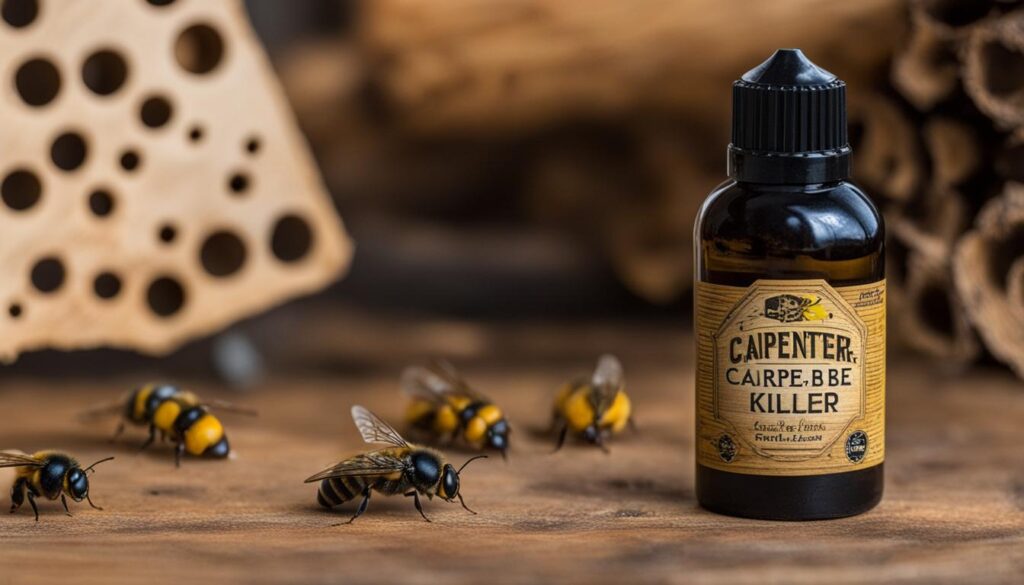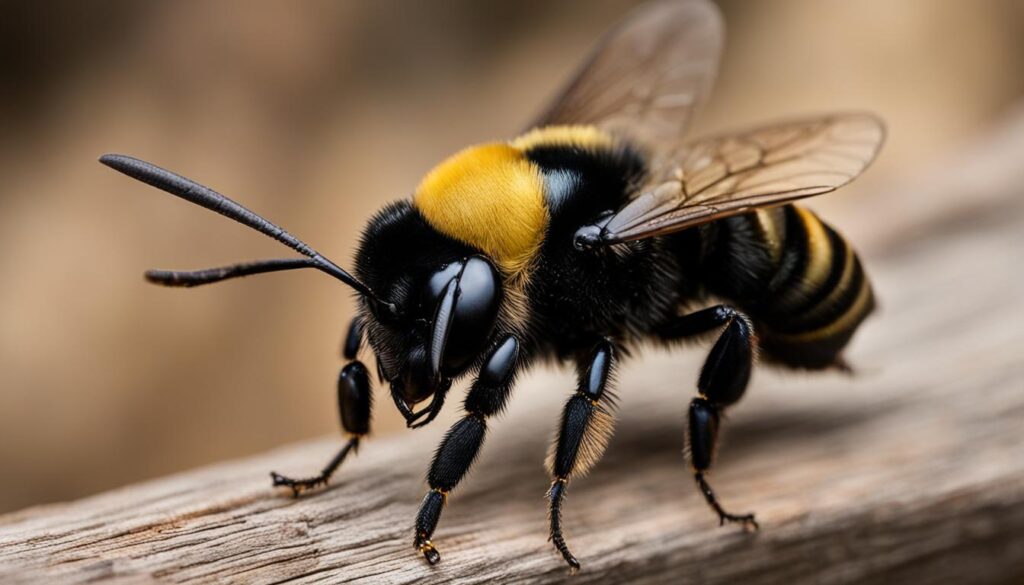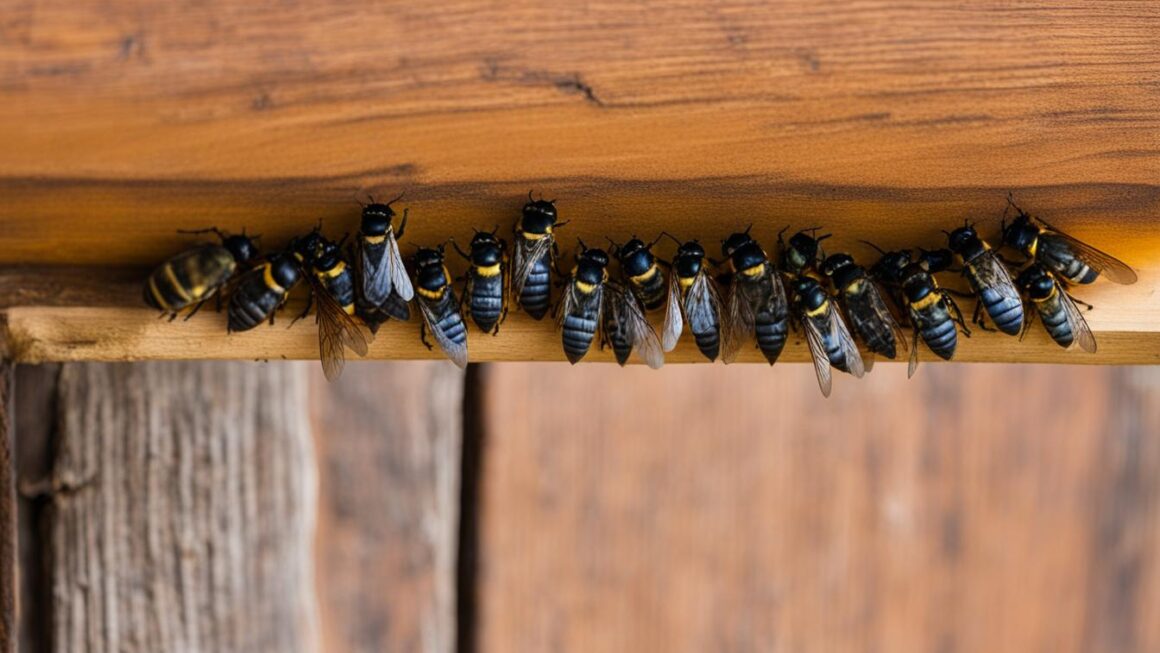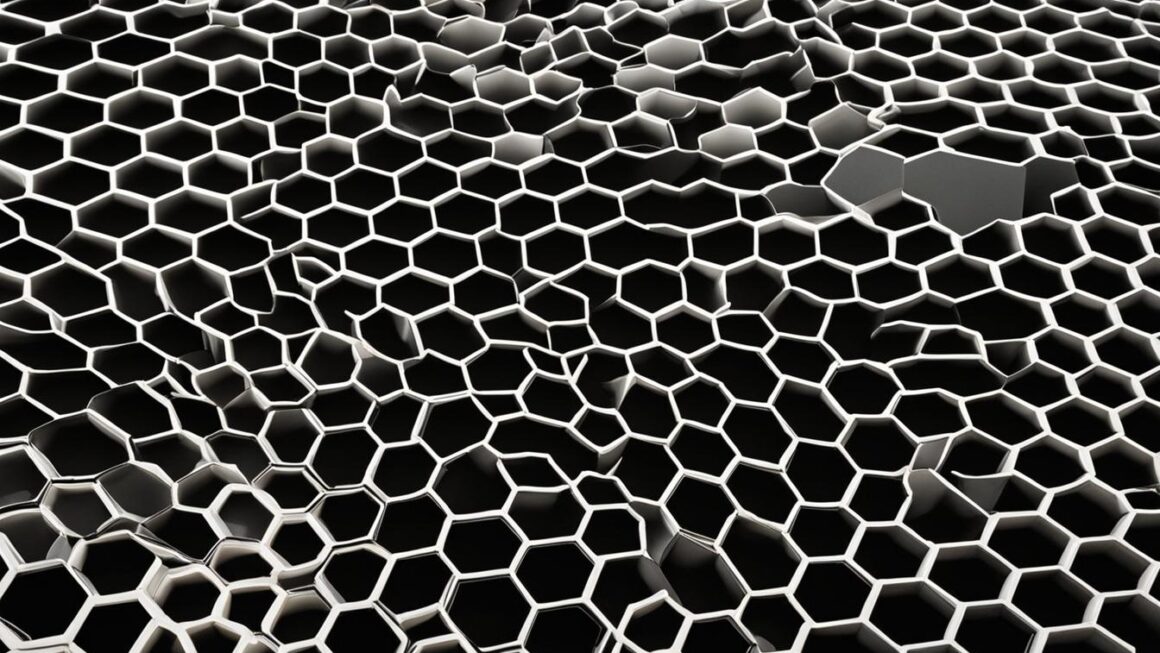Are you dealing with pesky carpenter bees causing damage to your wooden structures? Don’t worry, there are effective solutions available to eliminate these buzzing pests. One of the most effective methods is using an insecticide spray specifically designed to kill carpenter bees. By applying this spray, you can prevent the bees from causing further damage and ensure your wooden structures remain intact.
Key Takeaways:
- Applying an insecticide spray is the best method for preventing carpenter bees.
- Once carpenter bees have created holes in wood, an insecticide dust can be used to kill them.
- Homemade citrus sprays, essential oils, traps, and vacuuming are alternative options for bee control.
- Natural sprays like eucalyptus and tea tree oils can repel carpenter bees.
- Using a top-rated spray, such as Avesta CS, ensures effective elimination of carpenter bees.
By taking proactive measures and using the right spray, you can protect your wooden structures from carpenter bee damage and maintain a pest-free environment.
The Importance of Carpenter Bee Control
Carpenter bees can cause significant damage to wooden structures, making effective control and prevention measures crucial. These bees create nesting tunnels in untreated wood, weakening the structure and attracting woodpeckers. To protect your property from carpenter bees, it is essential to utilize carpenter bee control spray and repellent spray.
Using carpenter bee control spray can prevent these bees from causing damage to your wooden structures. This type of spray is specifically designed to target and eliminate carpenter bees, ensuring that they do not create nesting tunnels or further weaken the wood. By regularly applying carpenter bee control spray to areas prone to infestation, you can effectively protect your property.
In addition to control spray, carpenter bee repellent spray can deter these bees from nesting in the first place. This type of spray emits a scent that carpenter bees find unappealing, preventing them from establishing nests in the treated areas. By using a carpenter bee repellent spray, you can discourage carpenter bees from targeting your wooden structures and reduce the risk of damage.
The Importance of Carpenter Bee Control
| Benefits of Carpenter Bee Control | |
|---|---|
| Prevents costly damage to wooden structures | Protects against woodpecker attacks |
| Preserves the structural integrity of buildings | Reduces the risk of infestation |
| Minimizes the need for costly repairs | Ensures a pest-free environment |
By prioritizing carpenter bee control and utilizing the appropriate sprays, you can safeguard your wooden structures from damage and preserve their structural integrity. Effective prevention and control measures will help you maintain a carpenter bee-free environment and avoid costly repairs in the future.
Homemade Sprays for Carpenter Bees
Carpenter bees can be a nuisance, but there are effective homemade sprays that can help repel them from nesting in your wooden structures. These DIY sprays are safe for plants and other insects while deterring carpenter bees. One option is citrus spray, which can be easily made by boiling sliced citrus fruit and straining the liquid.
Other essential oils such as lavender, Jojoba, almond, and citronella can also be effective in repelling carpenter bees. These oils can be mixed with water and sprayed directly onto the nesting holes or areas where bees are likely to congregate. The strong scent of these essential oils is unpleasant to carpenter bees and can discourage them from nesting.
Homemade Carpenter Bee Spray Recipe:
- Boil sliced citrus fruit in water for 20-30 minutes.
- Strain the liquid and let it cool.
- Pour the citrus spray into a spray bottle.
- Spray the mixture into the carpenter bee nesting holes or areas where they are active.
Remember to wear protective clothing and take necessary precautions when using any spray, even homemade ones. While these homemade sprays can be effective in repelling carpenter bees, it’s important to note that they may not provide complete elimination of the bees. If you have a severe infestation or are unable to control the problem with homemade sprays, it may be necessary to consult a professional pest control service.
| Pros | Cons |
|---|---|
| Safe for plants and other insects | May not provide complete elimination |
| Easy to make with common household ingredients | Requires regular application for effectiveness |
| Environmentally friendly alternative to chemical sprays | May require professional pest control for severe infestations |
Natural Sprays for Carpenter Bees
Carpenter bees can be a nuisance, causing damage to wooden structures and posing a threat to your property. If you’re looking for natural alternatives to chemical insecticides, there are several natural sprays that can help repel and deter carpenter bees.
Eucalyptus Oil Spray: Eucalyptus oil has a strong scent that carpenter bees find unpleasant. By mixing a few drops of eucalyptus oil with water in a spray bottle, you can create a natural spray to deter these bees. Simply spray the mixture in areas where carpenter bees are active, such as around wooden structures or near their nesting holes.
Tea Tree Oil Spray: Tea tree oil is another effective natural repellent for carpenter bees. Mix a few drops of tea tree oil with water in a spray bottle and apply it to affected areas. The strong scent of tea tree oil will deter carpenter bees from nesting and help keep them away from your property.
Did You Know? Carpenter bees are often attracted to unfinished or weathered wood. Applying natural sprays can help protect your wooden structures and discourage these bees from causing damage.
Using natural sprays for carpenter bees provides an environmentally friendly alternative to chemical insecticides. However, it’s important to note that natural sprays may need to be reapplied more frequently compared to chemical sprays to maintain their effectiveness.
| Natural Sprays for Carpenter Bees | Effectiveness | Application |
|---|---|---|
| Eucalyptus Oil Spray | Repels carpenter bees with its strong scent | Mix a few drops of eucalyptus oil with water in a spray bottle and apply to affected areas |
| Tea Tree Oil Spray | Deters carpenter bees with its powerful aroma | Mix a few drops of tea tree oil with water in a spray bottle and spray in areas where carpenter bees are active |
By using natural sprays, you can protect your wooden structures from carpenter bee damage while avoiding the use of harsh chemicals. Remember to reapply the sprays as needed to ensure continuous protection against these pests.

Top-Rated Spray to Eliminate Carpenter Bees
Carpenter bees can be a nuisance and cause damage to wooden structures. To effectively eliminate these pests, using a top-rated spray is crucial. The best spray for carpenter bees is an insecticidal spray called Avesta CS. This powerful spray is specifically designed to target and kill carpenter bees, providing a quick and efficient solution to eliminate infestations.
When using Avesta CS, it is important to follow the instructions carefully. Begin by identifying the nesting areas of the carpenter bees. These bees typically create holes in wooden structures such as decks, porches, and fences. Once the nesting areas are identified, apply the insecticidal spray directly into the holes. The spray will penetrate deep into the nest, effectively killing the carpenter bees within minutes. To ensure complete eradication, it is recommended to treat the nesting areas multiple times, especially during peak activity periods.
Avesta CS is a top-rated spray for carpenter bees due to its potency and long-lasting effects. The active ingredient in this spray, cyfluthrin, is highly effective in killing carpenter bees on contact. Additionally, the residual effects of Avesta CS provide continued protection against future infestations. This makes it an ideal choice for homeowners who want to eliminate carpenter bees and prevent them from returning.
Benefits of Using Avesta CS
- Fast-acting: Avesta CS kills carpenter bees within minutes of application.
- Effective: The potent formula of Avesta CS ensures complete eradication of carpenter bees.
- Long-lasting: The residual effects of Avesta CS provide continued protection against future infestations.
- Easy to use: Avesta CS comes in a convenient spray bottle, making it simple to apply to the nesting areas.
- Safe for use: While Avesta CS is highly effective against carpenter bees, it is safe to use around pets and children when used as directed.
| Product Name | Active Ingredient | Kills on Contact | Residual Effects | Safe for Use |
|---|---|---|---|---|
| Avesta CS | Cyfluthrin | Yes | Yes | Yes |
| Other Sprays | Varies | No | No | Varies |
When comparing Avesta CS to other sprays on the market, it stands out as the top-rated spray to eliminate carpenter bees. While other sprays may claim effectiveness, Avesta CS has been proven to provide superior results. Its ability to kill carpenter bees on contact and provide long-lasting protection makes it the best choice for homeowners dealing with carpenter bee infestations.

Carpenter Bee Prevention Tips
To prevent carpenter bees from returning and causing damage to your wooden structures, there are several effective preventative measures you can take. By following these tips, you can maintain a carpenter bee-free environment.
1. Treat the Wood
One of the best ways to prevent carpenter bees from nesting in your wooden structures is to treat the wood with almond or citrus oils. These scents are known to be deterrents to carpenter bees. Simply apply the oils to the surface of the wood, paying particular attention to any areas where bees may have previously nested.
2. Regular Maintenance
Regularly painting, staining, or treating the wood can also help deter carpenter bees. The protective coating created by these maintenance tasks makes the wood less attractive for nesting. Additionally, keeping the wood in good condition through regular maintenance can help prevent further damage and infestations.
3. Insecticidal Sprays
Using insecticidal sprays as a preventative measure in late winter can be highly effective in keeping wooden structures bee-free. Applying the spray to potential nesting sites and areas where carpenter bees have previously been seen can help eliminate any existing bees and deter new ones from nesting. Be sure to follow the instructions on the spray carefully to ensure safe and effective use.
| Preventative Measure | Effectiveness |
|---|---|
| Treating the wood with almond or citrus oils | High |
| Regular maintenance (painting, staining, treating) | Medium |
| Using insecticidal sprays | High |
By implementing these preventative measures, you can significantly reduce the risk of carpenter bee infestations and protect your wooden structures from damage. However, if you already have a carpenter bee infestation, it is recommended to seek professional pest control services for effective elimination.
Signs of a Carpenter Bee Nest
When it comes to identifying a carpenter bee nest, there are several key signs to look out for. By recognizing these signs, homeowners can take prompt action to address the infestation and prevent further damage. Here are the most common indicators of a carpenter bee nest:
- Small, perfectly round holes in wood: Carpenter bees create entrance holes that are approximately a quarter inch in diameter. These holes are typically neat and perfectly round, without any jagged edges.
- Sawdust near the nest opening: As carpenter bees excavate their nests, they often leave behind piles of sawdust near the entrance holes. This is an important clue that carpenter bees are actively nesting in the wood.
- Excrement stains below the nest: Carpenter bees mark their territory by depositing excrement stains below the nest openings. These stains may appear as dark spots or streaks on the wood surface.
- Buzzing or humming sound near the hole: If you hear a buzzing or humming sound coming from a particular area of wood, it is likely that carpenter bees have established a nest there. The sound is caused by the bees’ activity within the tunnels they have created.
“Small, perfectly round holes in wood, sawdust near the nest opening, excrement stains below the nest, and a buzzing or humming sound near the hole are all signs of a carpenter bee nest.”
If you notice any of these signs in or around your home, it is important to take action promptly. Carpenter bees can cause structural damage over time, and addressing the infestation early can save you significant time and money on repairs. It is recommended to consult with a professional pest control service to safely and effectively remove the carpenter bees and their nests.
Protective Measures
To prevent carpenter bees from nesting in the future, consider taking the following protective measures:
- Apply a protective finish: Treating exposed wood surfaces with a protective finish, such as paint, stain, or varnish, can make them less attractive to carpenter bees.
- Fill and seal existing holes: If you have identified carpenter bee holes, fill them with an appropriate wood filler or putty and seal them to prevent reinfestation.
- Regular maintenance: Regularly inspect and maintain wooden structures around your property. Address any signs of damage or deterioration promptly to minimize the risk of carpenter bee infestations.
- Consult a professional: If carpenter bee activity persists or if you have a large infestation, it is advisable to seek the assistance of a professional pest control service. They can provide effective treatment options and long-term prevention strategies.
By staying vigilant and taking proactive steps, you can effectively manage carpenter bee infestations and protect your property from further damage.
Tips for Repairing Carpenter Bee Holes
If you have noticed carpenter bee holes in your wooden structures, it is important to take action and repair them to prevent further damage. Here are some tips on how to repair carpenter bee holes effectively:
1. Fill the holes
Start by filling the carpenter bee holes to restore the integrity of the wood. There are several options you can choose from, depending on the size of the holes. Steel wool or aluminum foil can be packed tightly into the holes to prevent bees from reusing them. Alternatively, you can use a dowel and wood glue to fill the holes, ensuring a secure and durable repair. Wood putty is another option that can be used to fill smaller holes.
2. Paint over the repairs
After filling the carpenter bee holes, it is recommended to paint over the repairs. This not only provides an aesthetically pleasing finish but also helps to deter bees from returning. Choose a high-quality paint that matches the color of the surrounding wood. Apply multiple coats if necessary, ensuring complete coverage of the repaired areas.
3. Regular maintenance
Prevent future infestations by implementing regular maintenance of your wooden structures. Inspect the wood periodically for any signs of new bee activity or damage. Touch up any areas that show signs of wear or damage, such as peeling paint or cracks. By staying vigilant and addressing any issues promptly, you can minimize the risk of carpenter bees causing further damage.
By following these tips, you can effectively repair carpenter bee holes and protect your wooden structures from further damage. Remember to fill the holes, paint over the repairs, and perform regular maintenance to ensure a pest-free environment. Taking proactive measures will help maintain the integrity of your wooden structures and prevent carpenter bees from returning.
Conclusion
In conclusion, the most effective way to eliminate carpenter bees and prevent infestations is by using the right spray. Insecticidal sprays, such as Avesta CS, provide quick and efficient results in killing these bees. By directly treating the bees and their nests, the infestation can be eradicated within minutes.
For those looking for natural and DIY alternatives, homemade sprays and natural sprays can also be effective. Homemade citrus sprays and essential oils like lavender, jojoba, almond, and citronella can repel carpenter bees without causing harm to plants and other insects. Eucalyptus and tea tree oils are natural options known to drive away these bees.
However, prevention is key in maintaining a carpenter bee-free environment. Taking proactive measures such as treating wooden structures with almond or citrus oils and regularly painting or staining the wood can deter carpenter bees from nesting. Additionally, using insecticidal sprays as a preventative measure in late winter can ensure the wood remains bee-free.
By following these tips and repairing any existing damage caused by carpenter bees, homeowners can protect their wooden structures and enjoy a pest-free environment. Effective spray options, whether insecticidal, homemade, or natural, provide the necessary tools to combat carpenter bee infestations and safeguard homes from costly damage.
FAQ
What is the best spray to kill carpenter bees?
The best spray to kill carpenter bees is an insecticide spray such as Avesta CS. This spray should be applied to the structure where the bees congregate before they cause damage.
Why is carpenter bee control important?
Carpenter bee control is important because these bees can cause expensive damage to wooden structures. They create nesting tunnels in untreated wood, weakening the structure and attracting woodpeckers.
Are there homemade sprays for carpenter bees?
Yes, you can make DIY sprays at home to repel carpenter bees. Citrus spray, made by boiling sliced citrus fruit and straining the liquid, can be sprayed into the nesting holes to repel the bees. Other essential oils such as lavender, Jojoba, almond, and citronella can also be effective.
What are natural sprays for carpenter bees?
Eucalyptus and tea tree oils are known to repel carpenter bees. By spraying these essential oils directly into the nest, the strong scent will drive the bees away. Natural sprays provide an environmentally friendly alternative for carpenter bee control.
What is the top-rated spray to eliminate carpenter bees?
A top-rated spray for eliminating carpenter bees is an insecticidal spray such as Avesta CS. This spray can be used to directly treat the bees and their nests, killing the bees within minutes.
How can I prevent carpenter bees from returning?
To prevent carpenter bees from returning, you can treat the wood with almond or citrus oils to make it less attractive to these bees. Regularly painting, staining, or treating the wood can also help deter carpenter bees. Using insecticidal sprays as a preventative measure in late winter can keep wooden structures bee-free and prevent infestations.
What are the signs of a carpenter bee nest?
Signs of a carpenter bee nest include small, perfectly round holes in wood, about a quarter inch in diameter. You may also see sawdust near the nest opening, excrement stains below the nest, and hear a buzzing or humming sound near the hole.
How can I repair carpenter bee holes?
Carpenter bee holes can be repaired by filling them with steel wool, aluminum foil, a dowel and wood glue, or wood putty. After filling the holes, painting over them will help deter the bees from returning and causing further damage.




